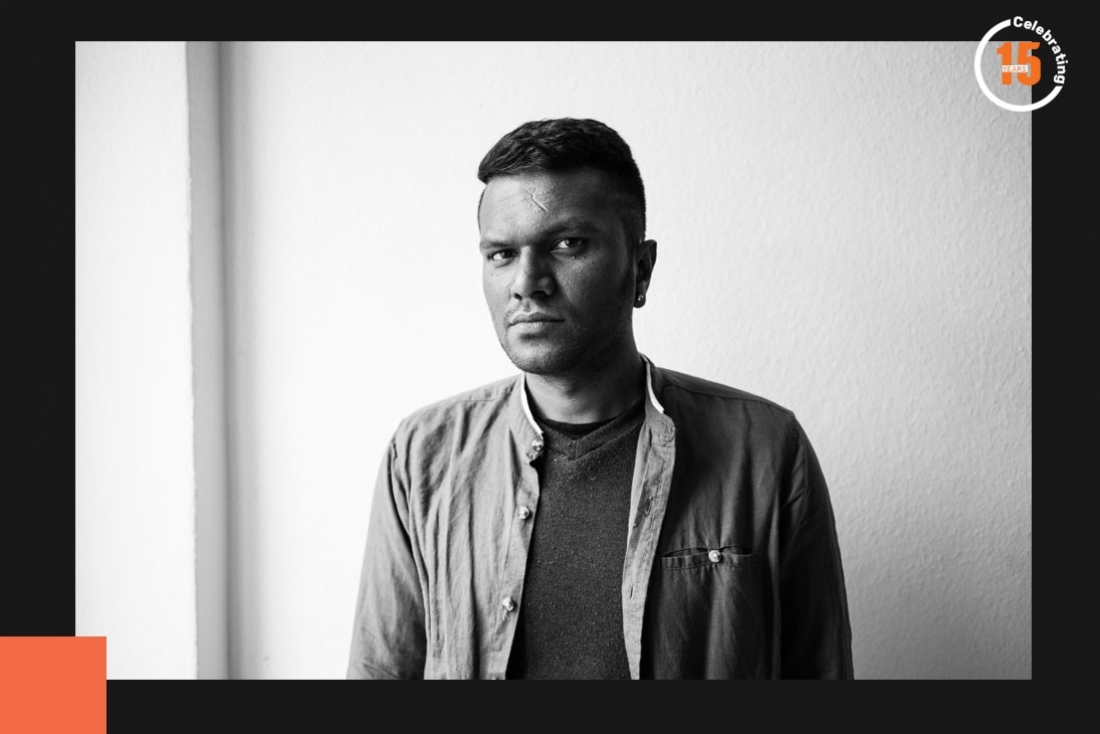
Photography: Morvarid K

Photography: Morvarid K
Performance art is all-embracing, transformative, fluid and powerful beyond measure. It does not conform to medium, is ever a work in progress, speaks a great deal in silence and challenges the artist who is also his work. If you closely enough, it is life as it would appear in evolution. In the case of Sajan Mani, it is the stark, stinging Black Dalit's life that plays storyteller.
He could be any man as he roams the streets in red, but he is the one artist whose act we eagerly await at the upcoming India Art Fair. But before, we must understand him better.
Define your practice.
My work can be best described as post-colonial black Dalit body in public space. Caste, which is a historical truth and everyday reality in India, is the subject matter of most of my works. I had worked as a political cartoonist [I stopped cartooning when I realised that my life is a cartoon], migrant labour in the gulf, and other odd jobs. I have studied English literature, Journalism, Fine Arts and Art in Public Spaces. My parents were rubber tappers [labour] in other people’s plantations. I had many, many bad experiences in public spaces. These personal experiences and my research reflect in my practice. Also, we don’t have a culture of archiving. When I started my performance practice around caste, I did not see many contemporary Indian artists interested in critically reflecting caste, which is a social reality in India and South Asia. As a migrant with a post- colonial black Dalit body, it is my responsibility to critically engage with the time in which I am living.
Mainly body, space and time are my materials and currently, I am experimenting with moving images and installations. I am also interested in what is not art or the boundaries of so called art and everyday life. I am always interested in history and alternative ways of archiving.
What inspires you?
Public spaces, bodies, everyday life and my own complex personal biography. I am fascinated and inspired by Taiwanese performance artist Tehching Hsieh, known for his One Year Performances.
Who do you become when you are performing?
A collective body, sometimes something else...it is an attempt to find new languages.
Does the performer direct your person or does your person direct the performer?
Both are the same, most of the time. Everything can be performance. Our time is in a ‘performative turn’.
How has your art evolved over the years?
I still need time to reflect on that.
Describe your creative process.
My works are the manifestations of long and serious results of researches and my own personal body experiences in the public space. My studios might be moving—I try to take notes, make drawings while am in public space. later, I might sit in my studio and work. Sometimes it starts with an image, sometimes a text. I will start looking into archives, books, research papers and other forms of archiving and forms, images and objects. I have a close circle of friends with whom I am always sharing the ideas, thoughts and processes. I have a huge interest in everyday objects. For the Kampala Biennale [Uganda] I had used a boat, which I had borrowed from a fisherman there. I think that process is still evolving somewhere. I love this kind of work which is still getting processed in another context, or another space. I think the process is my work, mostly. Also, I am into performative installations now.
What is the biggest challenge of being a performance artist?
Performance art as a practice is not easy at all, especially as an artist who is trying to test the limits of endurance and in turn getting many threats for the political nature of his works. It is very difficult to make a living out of this practice. Performance art has never been an easy way to make a living. I compensate for this by doing odd jobs.
Tell me about your work in progress.
I have just finished my project called Unlearning Lessons from my Father, with Asia Art Archive. It was curated by Meenakshi Thirukode. Unlearning Lessons from my Father is a poetic response to questions around archiving in which I look to my personal biography and its connection to the history of colonisation—particularly the forced migration of trees and plants [including cashew, pineapple, rubber, and tapioca]. My father and brother sold cashews at the nearest state border to send the children to school, and as I mentioned, my parents were rubber tappers working in various plantations in Kerala. I try to weave a narrative that connects the colonial and material histories of these fruits and plants to the personal histories relating to indigenous lands, bodies, and knowledge.
This conversation was initially published in our Art issue of 2019 and we are revisiting it as a part of our Celebrating 15 years of Platform magazine series.
Text Soumya Mukerji